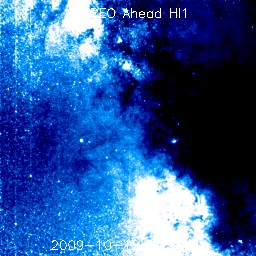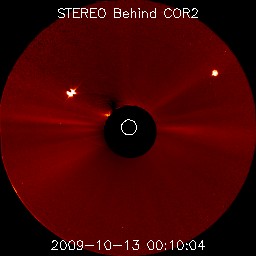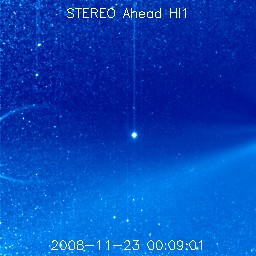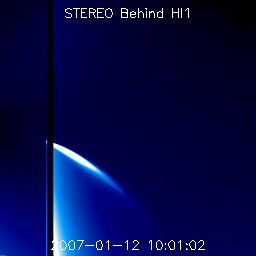Welcome to the STEREO Learning Center
Image artifacts - Stars, planets, and comets
Stars are always present in the STEREO COR2, HI1, and HI2 images, and can
sometimes be seen in COR1. Stars drift slowly from left-to-right with time,
caused by the
spacecraft orbiting around the Sun. Twice a year the Milky Way will drift
through the field-of-view, as in this example from the HI1 on STEREO Ahead.
 |
| The Milky Way passing through the field-of-view of the STEREO
Ahead HI1 telescope on October 12, 2009. Click on any image for a
higher resolution version. |
Often, planets can also be seen passing through the telescope fields-of-view.
The STEREO Planet Finder
page shows what planets are currently visible in the STEREO telescopes, while
the STEREO Orbit Tool
shows the positions of the planets in the solar system for any given date
during the mission. Most planets are too bright for the sensitive optics in
the STEREO coronagraphs, causing them to appear overly large and distorted.
Note the "butterfly" shape of Venus in the COR2 image below, caused by
diffraction off the occulter stem. In the HI1 and HI2 images, planet images
and particularly bright stars will also be accompanied by vertical streaks
(either white or black), which is due to the shutterless readout of the cameras
on these telescopes. Most planets will move from left to right, but the inner
planets Mercury and Venus often are seen moving from right to left.
 |
|
 |
| The planets Venus (left) and Mercury (right) as seen by the
STEREO Behind COR2 telescope on October 13, 2009 |
|
Jupiter as seen by the STEREO Ahead HI1 telescope on September
1, 2008 |
Occasionally, even bright comets can cause vertical streaks in the data. Here
is an image of Comet McNaught as it appears in HI1-B on the SSC website. Note
the large dark vertical dark streak, and the smeared brightness toward the
bottom of the image, both effects caused by the high brightness of this
particular comet. Advanced techniques exist for removing some of these effects
from the images, but these are not applied routinely on the SSC website.
Better images of Comet McNaught are available on the
STEREO Gallery. Additional information about comets seen by STEREO can be
found on the
Sungrazer website.
 |
| Comet McNaught as seen by the
STEREO Behind COR2 telescope on January 12, 2007 |
Back to image artifacts page.
Last Revised: Tuesday, 25-Nov-2025 11:58:33 EST
Responsible NASA Official: ![[email address: therese.a.kucera<at>nasa<dot>gov]](/img/kucera_email.jpg)
Privacy Policy and Important Notices
Accessibility
Webmaster: Apexa Patel
|